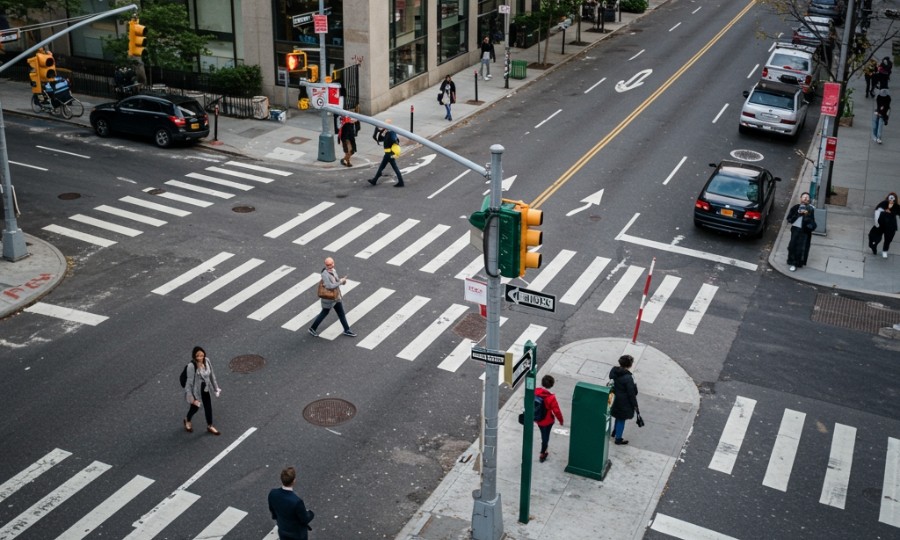
Navigating New York City: The Evolution of Pedestrian Safety and Accessibility
New York City, a vibrant metropolis, constantly evolves. Its streets, once primarily designed for vehicle flow, are undergoing a significant transformation. The NYC Department of Transportation (DOT) actively implements street design changes to enhance pedestrian safety, creating a more inclusive and secure urban environment for everyone. These upgrades are not just about convenience; they are about saving lives and improving the quality of life for millions of residents and visitors.
At RMFW Law, we understand the critical importance of safe streets. We continually monitor these developments, advocating for pedestrians and ensuring their rights are protected. The city’s commitment to modernizing its infrastructure directly impacts pedestrian well-being, a cause we champion vigorously.
Expanded Pedestrian Spaces: More Room to Move
One of the most visible changes involves expanding pedestrian spaces. The DOT recognizes that wider sidewalks and dedicated pedestrian plazas provide crucial benefits. They reduce overcrowding, minimize conflicts between pedestrians and vehicles, and create a more pleasant walking experience.
For instance, initiatives to convert underutilized street space into pedestrian-only areas or widen existing sidewalks have gained momentum. These expanded zones offer more than just extra room; they foster a sense of community, encourage walking, and support local businesses by inviting more foot traffic. Suddenly, a chaotic intersection can become a vibrant public square, thanks to thoughtful urban planning.
Intersection Safety Upgrades: Making Crossings Safer
Intersections are often danger zones for pedestrians. The NYC DOT addresses this through comprehensive intersection safety upgrades. These improvements aim to reduce the likelihood of collisions and protect vulnerable road users.
Shorter Crossings and Raised Crosswalks
Many redesigns involve shortening pedestrian crossing distances. This reduces the time pedestrians spend in the street, directly lowering their exposure to traffic. Additionally, raised crosswalks are becoming more common. These act as speed bumps for vehicles, forcing drivers to slow down as they approach and cross pedestrian pathways. This simple yet effective design element significantly enhances safety.
‘Daylighting’ Intersections: Improving Visibility for Everyone
Another crucial strategy is ‘daylighting’ intersections. This practice involves removing parking spaces or other obstructions within a specific distance (typically 20-30 feet) of a crosswalk. By clearing these zones, drivers gain an unobstructed view of pedestrians approaching or in the crosswalk, and pedestrians can see oncoming vehicles more clearly. Daylighting dramatically improves sightlines, especially for children or individuals using wheelchairs, preventing collisions that might occur due to blind spots. It’s a proactive measure that prevents accidents before they happen.
Accessibility Upgrades: Streets for All Commuters
Beyond general safety, the NYC DOT is making significant strides in accessibility. These upgrades ensure that streets are safer and more navigable for all commuters, especially those with disabilities. True urban planning considers the needs of every individual, promoting independence and mobility.
Accessible Pedestrian Signals (APS): Guiding the Way
The installation of Accessible Pedestrian Signals (APS) represents a major leap forward. These specialized signals provide crucial information to visually and hearing-impaired pedestrians. APS units include audible tones, vibrating surfaces, and sometimes even spoken messages, indicating when it is safe to cross the street. This technology empowers individuals who might otherwise face significant challenges navigating busy intersections, ensuring they can cross confidently and safely. The deployment of APS across the city demonstrates a strong commitment to inclusive design.
Bus Boarding Islands: A Safer Way to Board
Bus boarding islands are another innovative accessibility feature. These raised platforms are built into the street, separating waiting bus passengers from moving traffic. Buses pull up directly to the island, allowing passengers to board and alight safely without stepping into the street. This design not only protects passengers but also improves bus efficiency by reducing dwell times and preventing vehicles from blocking the bus lane. For individuals with mobility challenges, these islands eliminate the dangerous step down from a curb into the street, making public transit more accessible and less hazardous.
Curb Ramps and Detectable Warning Surfaces
Complementing these larger initiatives are ongoing efforts to install and maintain compliant curb ramps at every intersection. These ramps provide smooth transitions from sidewalks to streets, essential for wheelchair users, parents with strollers, and individuals with walking aids. Paired with detectable warning surfaces (often textured, truncated domes), these features alert visually impaired pedestrians to the edge of the sidewalk and the presence of a street crossing. These seemingly small details collectively create a network of accessibility that transforms the urban landscape.
The Impact on NYC Residents and the Role of RMFW Law
These infrastructure and accessibility upgrades have a profound impact on the daily lives of New Yorkers. They contribute to a city where walking is safer, more enjoyable, and accessible to everyone, regardless of age or ability. Reduced pedestrian injuries and fatalities represent the ultimate goal, fostering a healthier and more connected community.
However, even with the most advanced safety measures, accidents can still occur. When they do, the consequences for pedestrians can be devastating. At RMFW Law, we remain dedicated to representing victims of pedestrian accidents. Our team understands the complexities of New York City’s traffic laws and the nuances of accident claims. We work tirelessly to ensure that injured pedestrians receive the compensation they deserve for medical expenses, lost wages, and pain and suffering.
Knowing your rights is paramount in a city constantly striving for safer streets. If you or a loved one experiences a pedestrian accident, understanding your legal options can make a significant difference. We provide expert guidance, offering clarity and support during challenging times.
Conclusion: A Future of Safer, More Accessible Streets
The NYC Department of Transportation’s initiatives—from expanding pedestrian spaces and daylighting intersections to installing Accessible Pedestrian Signals and bus boarding islands—demonstrate a clear commitment to pedestrian safety and accessibility. These upgrades are transforming New York City into a more walkable, equitable, and secure urban environment. While progress continues, vigilance and legal advocacy remain essential. RMFW Law stands ready to assist, ensuring that as the city evolves, the rights and safety of its pedestrians are always at the forefront.
Free Case Consultation
Injured in an accident? Contact Rosenberg, Minc, Falkoff & Wolff for a free and confidential case review with an experienced NYC personal injury attorney.


